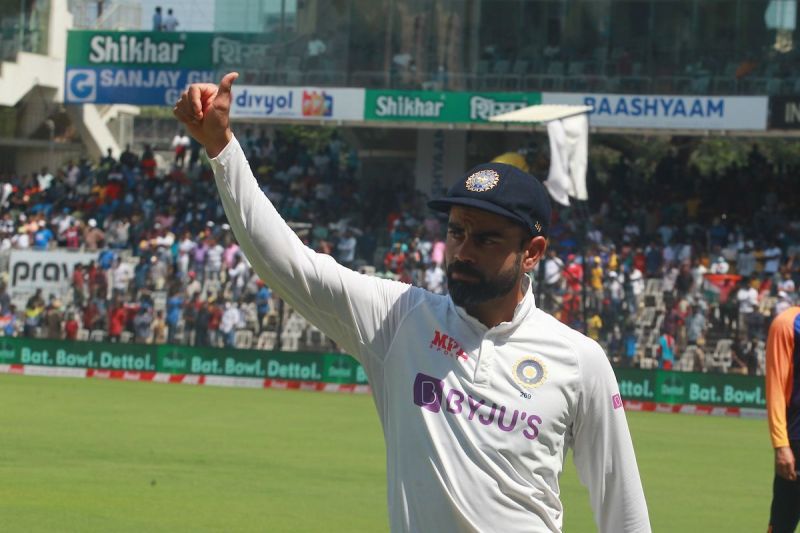
Chennai pitch, Test cricket and why the Virat Kohli-era in India hasn’t been all about spin

A searing debate surrounding the Chennai pitch was underway on social media during the second India v England Test.
From fans to pundits, everyone seemed to have an opinion on the kind of surface India dished out for the match.
Critics of the Chennai surface included cricketer-turned-broadcaster Jonathan Agnew. He wrote an article for BBC titled, “You may as well play on a beach – Chennai pitch not good for Test cricket.” He argued that surfaces like the one in Chennai are poor advertisements for Test cricket.
But if a no. 8 buckles in and scores a ton, is it actually a poor advertisement for the format?
For decades, the English, or most visitors from SENA (South Africa, England, New Zealand and Australia) countries, have viewed Tests in India through a prism of treachery.
The double standards continue to surprise – mastering swing and seam is an art, so is scoring against it. But spin is treacherous and pitch-reliant, and surviving on it is not a skill but a lottery.
There’s a general consensus that India's rise in Tests under Virat Kohli is completely down to their reliance on dustbowls at home.
But that is not the case.
The Virat Kohli-era for India at home


Of course, the conditions in the subcontinent help spin bowling more than pace. But the numbers reflect how Indian pacers have been as brilliant at home.
The numbers also signify how the surfaces in India have assisted both disciplines. Which makes it a case of mastery of the SG ball over conditions.
Indian spinners and pacers have collaborated well overseas too which results prove.
In contrast, the pace vs spin average in England during the same time stands at 27.38 and 36.5.
There's also little talk of the 2019 England-Ireland Lord's Test. 85 was all the hosts could manage in the first innings. Even then they won the Test by cleaning up Ireland for 38 in the fourth innings.
The surfaces for Lord’s Test against India in 2014 and 2018 were tailor-made for England pacers. Nobody complained.
The Trent Bridge surface during 2015 Ashes escaped criticism too. Australia were bundled out for 60 in the match.
Later that year, but, the Nagpur track would find itself in the ‘diabolical’ category.
Almost always, the wickets in SENA are labeled 'testing'. While in the subcontinent, they are termed 'sandpits'.
So the hullabaloo over the Chennai track is far from surprising.
Chennai pitch for India-England 2nd Test was not toss-dependent
The disproportionate help for spinners wasn’t surprising as the venue was holding back-to-back Tests.
But was the surface unplayable? One side scored over 600 while the other struggled to add even 300. Definitely it's a case of the better side dominating.
The beauty of Test cricket lies in the diversity of geography, soil, and weather conditions. Wouldn't non-challenging surfaces make the sport boring? Test cricket tests you across conditions.
For all the talk about pitches lasting five days and how the England master in preparing them, these bits of stats bust the hypocrisy:
Every team plays the home advantage card. And if England arrived hoping otherwise, then it was a strategic blunder.
In 2015, the Nagpur surface spun big, and South Africa had no answer. But New Zealand beat India in the 2016 T20 World Cup three months later at the same venue, using a spin-heavy attack.
The Kiwis dropped Tim Southee and Trent Boult and played three spinners. Though a different format, New Zealand had a strategy in sync with the nature of the pitch.
England could have played in-form James Anderson and Dom Bess instead of prioritizing the rotation policy in an all-important series.
More than most of the pundits, England captain Joe Root gave a more transparent account of things.
“It’s a bit of an education. We’ve got to learn from this because sometimes these are the conditions that you come up against. We’ve got to find a way of scoring runs in these conditions, finding ways to build pressure for long periods with the ball, and bowling six balls at one batter. Credit to India, they made that very difficult for us,” said Root after the end of the second Test.
Reflecting on the defeat, Root conceded that toss "didn't dictate which team won the game".
“The toss was an important one to win. I don’t think it necessarily dictated which team won the game. But we would have certainly liked to bat first on this pitch. India made the most of that opportunity. We didn’t perform well enough in our first innings. We did take a cluster of wickets in the second innings. If we had been closer to their first-innings total, it might have changed the momentum of the game.
“Was the pitch a good one? I wouldn’t say it was a good pitch. It made for very exciting cricket. But the fact is we were outplayed by them.”
The only importance of the toss was avoiding the pressure of a fourth-innings chase.
The surface spun from session one of the game, and while many struggled, Rohit Sharma didn't mind it at all. The plethora of full-tosses and short-pitched deliveries also helped Rohit's case.
Instead of being skeptical and critical over touring conditions in the pretext of 'saving Test cricket', English media need to focus on their spin handicap. The discipline is an art and requires mastery.
The two former cricketers who didn’t complain undoubtedly know a thing or two about the seemingly impossible act of beating India in India.
Spinners Monty Panesar and Graeme Swann claimed 17 and 20 wickets respectively in England's 2-1 win in India on the 2012-13 tour.
India haven't lost a home series ever since.